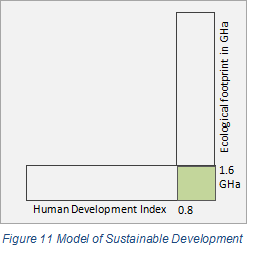What is Sustainable Development (SD)?
For Step 6
To understand what “sustainable development” means, one may start by reflecting on the meaning of the conjoined words. So, “sustainable development” refers to a process that finally leads to the intended aim “sustainability”. To get an idea about and understand what “Sustainable Development” means, we have to have clarity about the term “Sustainability”. Therefore, our explanation starts with the question, what is the meaning of Sustainability?
In Europe, the concept of a process being sustainable came up in the beginning of the 18th century in the context of forest and mining. It was realized that there will always be enough wood as long as you do not cut more wood than can grow in the time that it takes to cut the wood. This 18th century concept provides us with a basic idea, if not a clear understanding of “sustainable development”.
In 1987, the World Commission on Environment and Development (Brundtland Commission) Report, Our Common Future, described sustainable development as “development that meets the needs of the present without compromising the ability of future generations to meet their own needs.”
An explanation of the difference between sustainable development and sustainability as suggested by UNESCO is:
Sustainability is often thought of as a long-term goal (i.e., a more sustainable world), while sustainable development refers to the many processes and pathways to achieve it (e.g., sustainable agriculture and forestry, sustainable production and consumption, good government, research and technology transfer, education, and training, etc.).
A much clearer concept of sustainability is presented with the interplay of the human development index (HDI) with the ecological footprint (EF) which defines sustainability in a mathematical, and therefore measurable, way.
According to this model, a social group or society may be sustainable when their HDI score is above 0.8 per capita, which indicates a high standard of living, while their ecological footprint is less than 1.6 global hectare (gha) per capita.
Based on that we can state:
S = HDI > 0.8 + EF < 1.6 gha
S = sustainability
HDI = human development index
EF = ecological footprint
gha= global hectare

What is “sustainable development”?
Based on the above description of sustainability, what sustainable development means is easy to deduce: sustainable development describes the process by which individuals and/ or social groups achieve sustainability.
Or, to use the same metaphor, sustainable development is the path leading into the green corner of the model – no matter where an individual, social group or a country starts.
- Sustainable development for several African and Asian countries means the increase and improvement of their HDI while keeping a low ecological footprint.
- On the other hand, for majority of the “Developed World”, sustainable development means the decrease of their ecological footprint while keeping their high standard of living, measured as HDI.
- For middle income countries, sustainable development means an increase in their HDI score and a decrease of their ecological footprint.
Figure 12 Human Development and Ecological Footprint
Tasks
- Explain the idea of “sustainability”.
- Explain the concept of sustainable development.
- Find out the HDI score and ecological footprint data of your country.
- Locate the position of your country on the HDI and EF graph and trace the path to the point of sustainability.
- List some ideas to support the sustainable development of your country.


